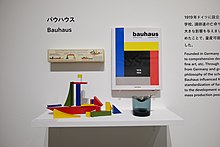Alma Siedhoff-Buscher
Alma Siedhoff-Buscher (born January 4, 1899 in Kreuztal near Siegen ; died September 25, 1944 in Buchschlag near Frankfurt am Main ) was a German designer and artisan at the Bauhaus in Weimar and Dessau.
Life
Alma Buscher attended the Margarethen Lyceum in Berlin and the Elisabeth women's school. From 1917 she studied for three years at the Reimann Art School and then at the teaching institute of the Kunstgewerbemuseum Berlin . From 1922 to 1925 she studied at the State Bauhaus in Weimar . There she was trained in wood sculpting by Georg Muche and Josef Hartwig and in form and color theory by Paul Klee . For the model house Am Horn for the Bauhaus exhibition in 1923, she designed the children's room together with Erich Brendel from functional furniture that caused a sensation. Her best-known works at the Bauhaus include the Small Ship Building Game (1923), which consists of 32 colored wooden pieces, and the Large Ship Building Game (1924) , which consists of 39 parts . For children she designed throw dolls (1923), the handicraft sheets crane and sailing boat (published in 1927 by Otto Maier-Verlag Ravensburg) and painting books (1930).
After her stay in Weimar, Alma Buscher studied and worked at the Bauhaus Dessau from 1926 to 1927 . In 1926 she married the actor and dancer Werner Siedhoff . In the same year their son, the future actor Joost Siedhoff , and in 1928 their daughter Lore were born. Walter Gropius refused to continue to support her work at the Bauhaus after the birth of her first child, which is why she left the Bauhaus in 1927 and gave up her profession as a designer. Due to the changing engagements of her husband, the couple moved several times. They lived in Drewitz near Potsdam from 1933 and in Frankfurt am Main from 1942. Alma Siedhoff-Buscher was killed on September 25, 1944 in a bomb attack in Buchschlag near Frankfurt am Main.
Exhibitions (selection)
- 1923: Children's room in the Am Horn model house .
- 1997: Bützelspiel and ladder chair. Designs for children by Alma Siedhoff-Buscher at the Bauhaus in Weimar (German Castle and Fittings Museum in Velbert )
- 2004–2006: Alma Siedhoff-Buscher: A New World for Children (2004–2005 Bauhaus Museum Weimar, 2006 Bauhaus Archive in Berlin )
Movie
Alma Siedhoff-Buscher is the role model for the protagonist Lotte Brendel in the film Lotte at the Bauhaus .
literature
- Ulrike Müller: The smart women of Weimar. Mistresses, salon ladies, writers and artists . Elisabeth Sandmann Verlag, Munich 2007.
- Amanda Boyaki: Alma Buscher Siedhoff: An Examination of Children's Design and Gender at the Bauhaus during the Weimar Period (Dissertation May 2010).
- Anja Baumhoff: Doctrine of the Cold? Implications of modern forms of discourse at the Bauhaus Dessau using the example of the history of Alma Buscher. In: Esotericism at the Bauhaus: A Revision of Modernity? International Scientific Symposium, Ed. Christoph Wagner. Berlin 2009, pp. 191-206.
- Susanne Radelhof: Bauhaus women . Documentary by Mitteldeutscher Rundfunk 2019; online , accessed February 13, 2019.
Web links
- Literature by and about Alma Siedhoff-Buscher in the catalog of the German National Library
- Alma Siedhoff-Buscher at bauhaus-online.de
- Annette Bußmann: Alma Siedhoff-Buscher at Fembio
- Jochen Stöckmann: The Bauhaus designer Alma Siedhoff-Buscher at Deutschlandfunk on September 25, 2019
- Alma Siedhoff-Buscher's student ID at the Bauhaus Dessau
Individual evidence
- ↑ a b Susanne Radelhof Bauhaus women. Documentary by Mitteldeutscher Rundfunk 2019; online , accessed February 13, 2019.
- ↑ Hans Hoff, Gerhard Matzig: Much Lotte, little Bauhaus. sueddeutsche.de , February 13, 2019, accessed on February 14, 2019 .
| personal data | |
|---|---|
| SURNAME | Siedhoff-Buscher, Alma |
| BRIEF DESCRIPTION | German artisan |
| DATE OF BIRTH | January 4, 1899 |
| PLACE OF BIRTH | Kreuztal |
| DATE OF DEATH | September 25, 1944 |
| Place of death | Book entry near Frankfurt am Main |
